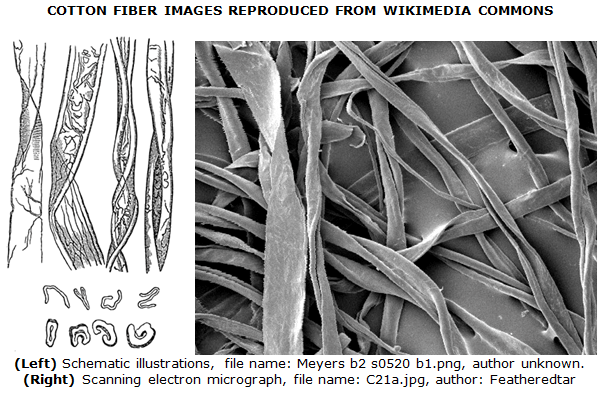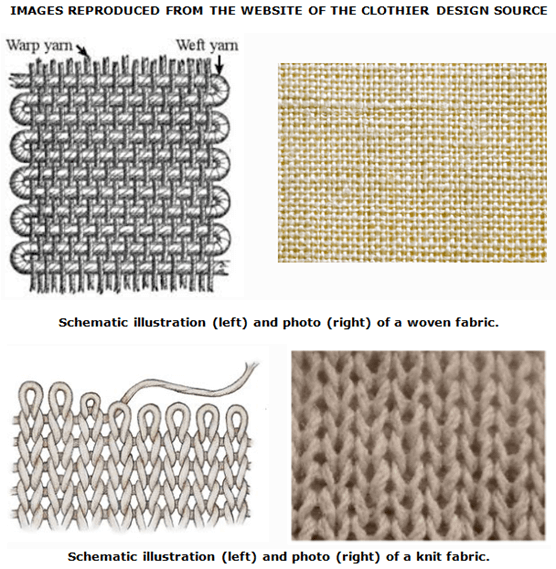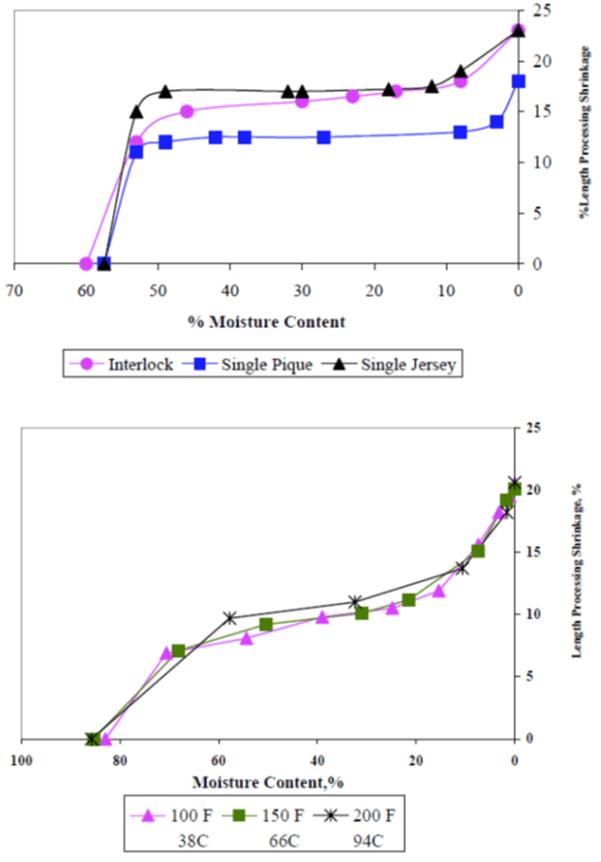SHRINKAGE OF COTTON TEXTILES
More than 90% of a cotton fiber consists of cellulose. The exact percentage of cellulose in a specific cotton fiber sample depends on whether the fiber is wet or dry, and on how much effort has been made to extract the non-cellulosic components. For example, when it is equilibrated at 65% relative humidity at 20 oC, cotton contains slightly more than 7% of absorbed water by weight. Hence the percentage of cellulose in a cotton fiber can range anywhere from just a little over 90% (wet, and with none of its non-cellulosic components extracted) to >99% (dry, with most of its non-cellulosic components extracted).
Cellulose, whose repeat unit is pasted below, is a strongly hydrogen-bonding polymer.

Unlike synthetic (such as polyester, nylon, etc.) fibers, which can be spun in any desired length as straight fibers of fixed cross-sectional shape, cotton fibers are of finite length (typically 2.5 cm to 5.0 cm) and of bent (kidney-shaped) cross-sectional shape due to the details of the processes of growth and maturation of a cotton plant. The effective diameter of a cotton fiber typically ranges from 10 microns to 15 microns over this varying cross-section. Cotton fibers are, therefore, convoluted along their lengths, as shown in the images reproduced below from Wikimedia Commons.

The convolutions help cotton fibers (and hence cotton textile articles) manifest excellent stretch before break and other highly desirable mechanical and thermal properties. They also, however, provide potential for the incorporation of larger amounts of stresses than for most synthetic textiles during manufacturing processes, and hence for the typical observation of relatively high shrinkage for cotton textiles.
In manufacturing most (nonwoven fabrics are the exception) textile fabrics, polymeric fibers of any suitable type (natural, synthetic, or blends thereof) are processed to obtain yarns, and fabrics are then manufactured from these yarns. The two most common classes of fabrics constructed by using yarns are woven fabrics and knit fabrics. A third, but much less common, major class is braided fabrics. Many different weaving, knitting, and braiding patterns can be used, providing a vast design space for manufacturing textiles from any fiber-forming polymer or combination of fibers from such polymers. The following images show the difference between a typical woven fabric and a typical knit fabric. They are reproduced from the website of the Clothier Design Source. It can be seen that the major difference is that the yarns are interlaced in woven fabrics and interlooped in knit fabrics.

It was pointed out above that cellulose, which is a strongly hydrogen-bonding polymer, is the main ingredient of cotton. As cellulosic cotton fibers are converted into yarn and then yarn is converted into fabric, each process step introduces additional stresses into the final cotton textile article. These stresses are introduced by the pulling, stretching, and twisting operations involved in these manufacturing steps. Differences in fiber type, yarn construction, fabric construction, finishing formulations, and manufacturing methods result in different amounts of stress being built into the hydrogen-bonded network of a cotton fabric, and hence in different susceptibilities to shrink via stress relaxation.
Shrinkage occurs as a result of stress relaxation when a cotton textile article is washed and dried. The following factors determine the extent of stress relaxation and hence the extent of shrinkage during washing and drying cycles:
- Elevated temperatures.
- Chemical effects of water and detergents during the washing step.
- Mechanical effects of spinning in a hot environment during the washing step.
- Mechanical effects of tumbling in a hot environment during the drying step, unless the article is line-dried or laid flat to dry slowly.
AATCC Test Method 135-2018, Dimensional Changes of Fabrics after Home Laundering, is the most commonly used testing standard for quantifying the dimensional (length and width) changes of all fabrics suitable for home laundering when they are subjected to home laundering procedures. Four washing temperatures, three agitation cycles, and four drying procedures provide standard parameters to represent common home care options.
Different washing and drying processes disrupt the initially highly stressed hydrogen-bonded network of a new cotton fabric to different extents and hence also cause different amounts of shrinkage. The use of lower temperatures during the washing and drying steps and the use of milder detergents during the washing step reduce the extent of shrinkage per washing and drying cycle. However, if a cotton textile article is used for a long time and washed and dried many times, it will eventually shrink to a state where all of its built-in stress has relaxed. Shrinkage will happen, albeit more slowly and over a larger number of washing and drying cycles, even with the use of the mildest washing and drying conditions.
The combination of the many design variables and processing parameters can be optimized to minimize the shrinkage of a cotton textile article. However, the reduction of the amount of shrinkage is usually merely one of many important desirable attributes for a cotton textile article. Hence the optimization of the combination of all of the relevant parameters to obtain the fabric with best possible overall balance of properties may result in a fabric whose shrinkage exceeds the minimum possible amount that may have been attainable.
Since shrinkage is perceived by consumers as a highly undesirable attribute of a cotton textile article, many knit cotton fabrics are pre-shrunk before a garment is made from them. The pre-shrinking process relaxes much of the built-in stress and thus minimizes any further shrinkage that a consumer may observe after subsequent washing and drying cycles.
A common approach used in textile technology is to blend cotton fibers with other types of fibers to seek to obtain multiple benefits. The reduction of the shrinkage of cotton textiles by blending cotton fibers with other types of fibers is just one of the many benefits that are sought. Blends of cotton fibers with polyester fibers are most common. The percentage of polyester fiber used is determined by the desired overall balance of performance attributes. Cotton/polyester blend textile articles meeting different overall balances of performance attributes can be manufactured by using different percentages of polyester in the blend.
Cotton Incorporated is a nonprofit company that provides the resources and research needed to help other companies develop and market superior, innovative, and profitable cotton products. The company’s efforts are focused across every area of the cotton life cycle, from the fiber through the finished product. Its Technical Bulletin titled A GUIDE TO IMPROVED SHRINKAGE PERFORMANCE OF COTTON FABRICS is an authoritative practical resource. A summary of some important information from this Guide is provided below. The images shown in this summary were also reproduced from the Guide.
- Shrinkage is defined, in very precise terms, as a dimensional change in a fabric or a garment caused by an application of a force, energy, or change in environment that either allows the goods to relax or forces the fabric to move in a given direction.
- Woven fabrics are much more stable than knit fabrics and do not react as severely to stresses so that they are much less susceptible to shrinkage. However, much lower shrinkage specifications are demanded of woven fabrics so that the impact of processing stresses is just as important for cotton woven fabrics as they are for knit fabrics.
- The far greater susceptibility of knit fabrics to shrinkage as a result of stress relaxation is due to the interlooped layout of the yarns in a knit fabric, as illustrated below.
![Shrinkage of Cotton Textiles Shrinkage of Cotton Textiles]()
- Shrinkage can be divided into two types based on its causes; namely, construction shrinkage and processing shrinkage.
- Shrinkage is affected by the construction parameters of the fabric.
- Shrinkage is affected by the forces applied in processing in the dyeing and finishing departments as well as the apparel manufacturing facility.
- Shrinkage can be divided into two types based on the physical processes governing it:
- Elastic shrinkage is defined as a change in dimensions of a fabric as a result of the ability of the fabric to relax freely from tensions experienced during construction and other processing steps.
- Drying shrinkage is defined as dimensional change in a fabric when “deswelling” of fiber, yarn, and construction occurs in the drying step. The structure shrinks upon itself as a result of the physics of drying.
- The behavior of the % length processing shrinkage on % moisture content of some representative cotton fabrics during tumble drying is illustrated below.
- The upper chart shows data for three different fabric designs.
- The lower chart shows data for the same fabric at three different temperatures.
![Shrinkage of Cotton Textiles Shrinkage of Cotton Textiles]()
- The Guide also provides a detailed discussion on how to reduce shrinkage. It points out that the best chance to achieve low shrinkage in knit cotton fabrics is to engineer the product completely, from fiber selection through all processing steps. The parameters that can be optimized to achieve success are itemized as follows in this discussion:
- Proper product specifications and fabrication.
- Low tensions during wet processing (dyeing and extraction).
- Relaxation drying.
- Finishing with compaction and/or crosslinking agents.
- Low tension packaging for apparel manufacturing.


